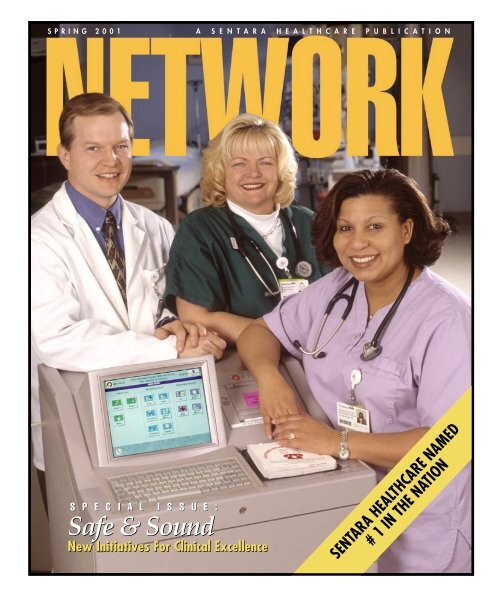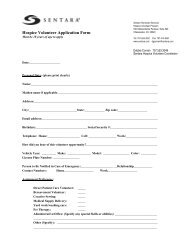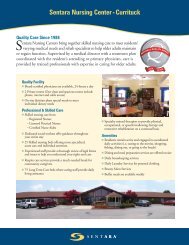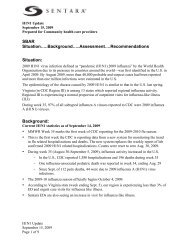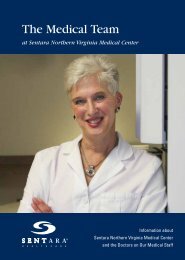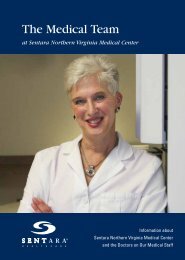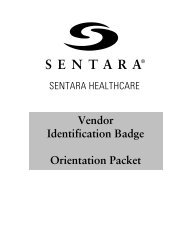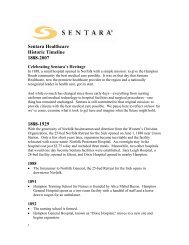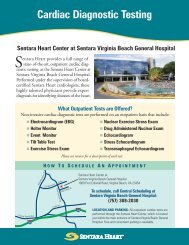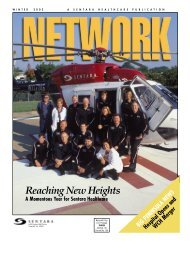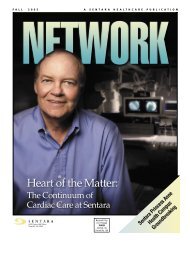E E - Sentara.com
E E - Sentara.com
E E - Sentara.com
- No tags were found...
You also want an ePaper? Increase the reach of your titles
YUMPU automatically turns print PDFs into web optimized ePapers that Google loves.
S P R I N G 2 0 0 1A S E N T A R A H E A L T H C A R E P U B L I C A T I O NS P E C I A L I S S U E :Safe & SoundNew Initiatives For Clinical ExcellenceSENTARA HEALTHCARE NAMED# 1 IN THE NATION
NETWORKCONTENTSWe’re # 1!! 3<strong>Sentara</strong> Healthcare # 1 in the NationSafe & Sound 5New Initiatives for Clinical ExcellenceI Get Around 6Deployed Pharmacy ProgramA SANE Approach 11Better Treatment for Sexual AssaultAround <strong>Sentara</strong> 12Familiar Faces and PlacesThis special edition of Network examines<strong>Sentara</strong>’s systemwide initiatives promoting patientsafety and excellent clinical out<strong>com</strong>es.There is no moreserious responsibilitythan the onewe take on every day,with literally thousandsof patients entrusted toour care. It’s not an easyjob, and it’s intense. Icontinue to applaud howwell you do it. In additionto helping the sickand injured get well, weare also charged withmaking sure they remainsafe in our facilities – anenvironment full of potential hazards.In keeping with a major nationalinitiative, <strong>Sentara</strong> is focusing on patientsafety. We have many effective programsin place, and more are <strong>com</strong>ing online every day. But not all of these programshave been designed accordingto a national, or even systemwide, template.Many are the result of creativeideas from our employees, the front lineclinicians and caregivers who saw whatwas working – and, just as importantly,what wasn’t – and took the initiative tofix it, and to make suggestions for programsand policies to better safeguardour patients.A big part of creating a cul-A MESSAGE FROMDAVE BERNDture of patient safetyrelies on reinforcementat every level. In movingfrom blame and fingerpointingto a non-punitive,proactive, team approach topatient safety, we must allplay a role. While it’s a naturalreaction to blame theperson who made the error,the overwhelming evidencepoints to the fact that he orshe isn’t the problem, but,instead, that mistakes flowfrom flawed or poor systemsand processes. And as we well know,mistakes can have tragic results.From a system perspective, we areredesigning our processes and proceduresto make error reporting moreefficient and easy. In-services and newtraining tools will also remind ouremployees and our patients to keep safetytop-of-mind. So use the Adverse DrugEvents hotlines, follow the employeesafety tips, keep educating each other– and our patients – about good safety.And remember that patient safety beginswith every one of us. Together, we willmeet the challenge.David L. BerndChief Executive OfficerVicky G. GrayVice President of Marketing andCorporate CommunicationsLisa P. SchulwolfExecutive EditorOn the cover: (L-R): Todd Shearon,clinical pharmacist, Marty Brock, RN, andVanessa Johns, RN, at a PYXIS Rx2000at <strong>Sentara</strong> Norfolk General Hospital’sCardiac Recovery Room.SpeakUpNETWORK wel<strong>com</strong>es ideas from ouremployees and affiliates. Don’t limityour suggestions to full-blownstories. Got a quote to share?Something going on in your division?Let us know by contacting:Lisa Schulwolfc/o Corporate Communications6015 Poplar Hall DriveSuite 101Norfolk, VA 23502(757) 455-7579FAX (757) 455-7964Or e-mail lpschulw@sentara.<strong>com</strong>All accepted submissions are subjectto editing and space limitations.For mailing questions, call:(757) 455-7540.NETWORK is publishedquarterly by <strong>Sentara</strong> to recognize– and celebrate! – our employeesand affiliates, our patients, othercustomers and our system as wework together to create a healthier<strong>com</strong>munity.(L-R): Ann Keffer and Elizabeth Scharlop, MD, discuss Sex After 60, one of the featured topics onExploreHealth.TV GUIDE…TO GOOD HEALTH!On Jan. 7, <strong>Sentara</strong> premiered aweekly, 30-minute cable-TV <strong>com</strong>munityeducation program. The series,called ExploreHealth with <strong>Sentara</strong>,examines medical breakthroughs,innovative treatment options andcontemporary health issues affectingour <strong>com</strong>munity. The series, hostedby <strong>Sentara</strong>’s own Ann Keffer, featureslocal and national physicians andhealthcare professionals.The show was created in responseto consumer demand, and is part ofa three-pronged approach to informas much of our <strong>com</strong>munity as possibleabout the programs and innovationsoffered by <strong>Sentara</strong>. (The showis <strong>com</strong>plemented by a monthly newsletterformat insert in regional newspapersand by a new section of the www.sentara.<strong>com</strong> website.)Program topics have included: heartdisease; the latest <strong>Sentara</strong> e-ICU technologies;effective treatments for heartburn;infertility and “new knees.”For more information about programtopics and a viewing schedule, or to receivea copy of the 2001 program guide, call1-800-SENTARA or visit our website atwww.sentara.<strong>com</strong>/explorehealth2 N e t w o r k Spring 2001
On Feb. 19, <strong>Sentara</strong>’s ChiefExecutive Officer DaveBernd along with VirginiaLt. Gov. John Hager announcedat a press conference that <strong>Sentara</strong>Healthcare has been named the TopIntegrated Health Network in theUnited States. State legislators, andelected local officials attended theevent along with local media.<strong>Sentara</strong> was ranked tops in thenation by SMG Marketing Group,a Chicago-based healthcare andinformation marketing <strong>com</strong>pany.SMG looked at <strong>Sentara</strong>’s level ofintegration and its ability to offer afull spectrum of services.Putting the Patient First<strong>Sentara</strong> Healthcare Named Nation’s Top Integrated Healthcare NetworkDave Bernd, CEO, announces the exciting news at a press conference on Feb. 19.“We strive to provide the residentsof our <strong>com</strong>munities with aseamless healthcare organization,and to be recognized for our work istruly an honor,” said David Bernd,CEO of <strong>Sentara</strong> Healthcare.Bernd says with an integratedhealthcare system patients shouldmove easily through the system,services should be more timely and<strong>com</strong>munication amongst care providersshould be better.“An integrated system makes iteasier for patients to receive the carethey need,” Bernd said. “It’s a winwinfor patients when their physicians,hospitals and health plan areall working together to improve thequality of their care.”Bernd credited his predecessorGlenn Mitchell and <strong>Sentara</strong>’sformer Chairman of the Board,George Middleton, with providingthe vision to transform <strong>Sentara</strong> froma hospital-based organization intoan integrated healthcare provider.“Glenn recognized very early thebenefits of bringing healthcare servicestogether for the patients. Hetruly started healthcare in Virginia.Also, it would not be an overstatementto say that George has made<strong>Sentara</strong> what it is today. He workedwith management and administrationin such a way that his stylehas be<strong>com</strong>e a model for healthcareorganizations all over the country,”Bernd said.<strong>Sentara</strong> is one of only threehealthcare systems in the nation tobe in the Top 10 for four straightyears. <strong>Sentara</strong> was ranked 6th inthe nation in 2000. SMG ranked theTop 100 Integrated Health Systems,out of more than 532 nonspecialtyregional integrated health systemsnationwide.<strong>Sentara</strong> Healthcare is the premierenot-for-profit healthcare providerin southeastern Virginia andnortheastern North Carolina.In determining the Top 100Integrated Health Systems, SMGMarketing Group looks at distinctcategorical performance in eachintegrated healthcare network,including services and access, hospitalutilization, physicians, integration,financial stability, outpatientutilization and contracts.In <strong>com</strong>piling its Top 100 rankings,SMG Marketing determinedthat 95 percent of the integratedhealth systems are not-for-profitand have a physician network thatis 58 percent larger than the average(L-R): Virginia Lt. Gov. John Hager and<strong>Sentara</strong>’s Chairman of the Board Donald H.Clark, confer at SNGH River Pavilion.Seniors “Net” New Service<strong>Sentara</strong> is proud to be a partnerin a statewide online initiativecalled SeniorNavigator.<strong>com</strong>, a subsidiaryof the Virginia HealthcareFoundation with support from theAOL Time Warner Foundation,the Collis Warner Foundation andother health organizations acrossVirginia.It is a unique Internet guidebookfor Virginia seniors, theirfamilies and caregivers.Designed to be easier than generalInternet search engines, thesite offers information in ninetopical areas: medical concerns;healthcare providers; pharmacyforum; insurance and benefits;future planning; assets and liabilities;housing; legal and <strong>com</strong>munity.By be<strong>com</strong>ing familiarwith the SeniorNavigator.<strong>com</strong> site,employees who work for <strong>Sentara</strong>’sLife Care and Home Care divisions,as well as those who workwith older patients throughout thesystem, are better able to assist clientsand their families in locatingfast, accurate information. The siteis maintained and continuouslyupdated in close cooperation with<strong>Sentara</strong> by employees fromSeniorNavigator.<strong>com</strong> located inRichmond.Check out SeniorNavigator.<strong>com</strong>, orgo to www.sentara.<strong>com</strong>/seniorsA GIVING SPIRIT:Foundation Update<strong>Sentara</strong> distributed $154,000 during its most recent round ofgrants to support <strong>com</strong>munity health programs and services inHampton Roads. This most recent disbursement brings the totalamount of monies awarded by the Foundation to more than $1million. (The Foundation was established in July 1998 to further<strong>Sentara</strong>’s not-for-profit mission of serving the <strong>com</strong>munity byidentifying health-related problems and needs that have gone unmet,addressing them and enabling solutions.)The most recent round of recipients includes: Planned Parenthoodof Southeastern Virginia; Mother Seton House Inc.; Serenity HouseSubstance Abuse & Recovery Program; Peninsula AIDS Foundation;Peninsula Institute for Community Health; Beach Health Clinic andChesapeake Care Free Clinic.N e t w o r k Spring 2001 3
AT TA I N I N G N E W L E V E L S O F C L I N I C A L E X C E L L E N C E T H R O U G H I M P R O V E D PAT I E N T S A F E T YSafe and SoundNO ONE WANTS WHAT’S BEST FOR OURPATIENTS… more than we do. We all strive, everyday, to provide the best patient care possible and todeliver the most promising treatments and out<strong>com</strong>es.To that end, and in keeping with a nationwideeffort, <strong>Sentara</strong> has launched a systemwide initiativekeenly focused on patient safety because we believe,and the data supports, that it is a critical factor incontinually improving and delivering excellence inclinical out<strong>com</strong>es.Hospitals all over America are trying out various processes,procedures and even philosophies to improve patientsafety. The goal is to reinvent patient care according to aclinically excellent health model following established protocols andpathways that have proved to raise quality while reducing errors. Inother words, we’re holding ourselves accountable, and daily measuringour efforts against the best of the best in our industry.“We know we’re not perfect, but we’re all the better becausewe’re willing to look at ourselves honestly, ask the hard questions,try new ways of doing things, and fix what isn’t working.Let’s remember, too, that this is a national issue – in fact, the JointCommission on Accreditation of Healthcare Organizations (JCAHO)recently approved new standards directly focused on patient safetyand medical/healthcare error reduction in hospitals,” said <strong>Sentara</strong>Healthcare Chief Medical Officer Rod Hochman, MD.Within our system each hospital is experimenting, doing thingsa little differently, to find what works best in its environment.“We are a proud organization that is not afraid to take a challengehead on. And we have the potential to be leaders in this area, andto attain clinical excellence to an unprecedented degree,”said Hochman.Network editors spoke with <strong>Sentara</strong>’s Executive MedicalDirector, Clinical Effectiveness, Gary Yates, MD, about <strong>Sentara</strong>’sPatient Safety Council and our safety initiatives. <strong>Sentara</strong>‘s strategy,in keeping with that of other leading healthcare organizations, is totake a three-pronged approach, simultaneously:▼ implementing major system solutions, such as new technologies▼ improving minor systems, such as actions targeted at a specificissue▼ changing organizational culture in the hospital inpatient,nursing home, medical office and home healthcare settings.Errors are divided into two categories: medication-relatedand non-medication related. A systemwide steering <strong>com</strong>mitteeprioritizes and provides direction for activities to improve bothmedication and non-medication related safety.The National Scene▼ A study by the Harvard School of PublicHealth found that 70 percent of adverse eventsrelated to medical errors were found to bepreventable, 24 percent were determined to beunpreventable, and 6 percent were potentiallypreventable.▼ A 1998 University of Toronto studyfound that roughly 100,000 Americans die ofadverse drug reactions each year, and 2.1 millionmore are hospitalized. The FDA receivedreports of more than 258,000 adverse drugevents in 1999, nearly quadruple the 68,000incidents reported a decade earlier. And FDAofficials acknowledge that they’re catchingonly a tiny fraction of these incidents.▼ In one study (Journal of AmericanMedical Association, 1999), a pharmacistdevoted a half-day each day for 10 months toac<strong>com</strong>pany physicians on rounds in a medicalintensive care unit. The on-site pharmacist preventedmedical errors by correcting in<strong>com</strong>pleteor inappropriate drug orders and by providinginformation on doses, interactions, indicationsand drug alternatives to physicians and nursingstaff. The result was a 66 percent reductionin medication errors, with cost savings estimatedat $270,000 per year.▼ A Jan. 22, 2001, article in the Los AngelesTimes reported: “Adverse drug reactions havereached epidemic proportions, killing morepeople each year than die on the nation’shighways, and doing serious damage to millionsmore. This problem has taken on specialsignificance recently: the FDA has pulled 10drugs off the market in the past three years forsafety reasons, which is unprecedented in theagency’s history.”▼ Medical errors (of all descriptions, notjust adverse drug events) can occur anywherein the healthcare system and are the fifth leadingcause of death and injury. A 1999 reportby the Institute of Medicine estimates that asmany as 44,000 to 98,000 people die each yearas a result of medical errors.N e t w o r k Spring 2001 5
M A J O R S Y S T E M S ODeployed Pharmacy Program* + PYXISOne example of a major systemsolution is the implementationof what most<strong>Sentara</strong> hospitals call the DeployedPharmacy Program. (*note: <strong>Sentara</strong>Virginia Beach General Hospital andWilliamsburg Community Hospitalrefer to it as the Clinical PharmacistProgram.)It includes an automated unitdose delivery system (called PYXISRx 2000) which is essentially anelectronic medicine cabinet, convenientlylocated on the medical units,and stocked with medicine appropriateto that population. PYXISbi-directionally interfaces with thehospital <strong>com</strong>puter system (TDS),and allows for automatic charting of(L-R): Vanessa Johns, RN, and ToddShearon, clinical pharmacist, work withPYXIS at <strong>Sentara</strong> Norfolk General Hospital.meds when the nurse withdraws themedication from the machine. Allmed orders given by the doctor areentered into the hospital <strong>com</strong>puterby Pharmacy staff. The pharmacistapproves the order, making sure it’sthe right dose for the patient’s age,weight, size, condition, before theorder crosses over to PYXIS. Onlythen can the nurse retrieve the drugfrom the machine. The deploymentof the PYXIS Rx 2000 was <strong>com</strong>pletedacross all <strong>Sentara</strong> hospitals in 1999.To date, the system is approximately90 percent <strong>com</strong>plete in implementingdeployed order entry across allhospitals. Pharmacy staff monitorand stock the machines.“We saw a significant opportunityto improve the basic medicationdistribution infrastructurewithin <strong>Sentara</strong>, so we redesignedthe system with the goals of achievingsafer and more accessible medicationdistribution, automateddocumentation, increased availabilityof drug information andquicker turnaround time for medicationorder entry,” said <strong>Sentara</strong>’sDirector of Pharmacy Services MarkSzalwinski.The system puts the pharmacistclose to the nurse, patient andphysician, which makes drug andpatient information about drugtherapy decisions more timelyand accurate, benefiting as it doesfrom the hands-on knowledge ofexperienced pharmacists. <strong>Sentara</strong>recruited a number of additionalpharmacists in recent years toimplement the program.“The Deployed PharmacistProgram interfaces order entryand pharmacists with physicians,nurses and patients. The pharmacistcan evaluate all orders to insurethe proper drug therapy and suggestalternatives if needed,” saysSzalwinski. <strong>Sentara</strong> currently hasmore than 40 deployed pharmacistsoperating throughout the system.In the past, nurses, patientsand doctors were on the unit, butthe pharmacist was generally in aremote department behind a counter.And because patients turn overand/or move from unit to unitquickly, it’s often hard to keep trackof them and make sure the rightmeds follow them and are availableat the right place at the right time.And it’s working: already <strong>Sentara</strong>hospitals are catching more adversedrug events and discovering thosethat occur are less severe.“It’s truly multi-disciplinary,everyone plays a role and feelssupported as a member of theteam. Pharmacists in particular(L-R): Jerry Mick, respiratory therapist,and Lynn Murphy, RN nurse manager,4 east/4 west, work together at <strong>Sentara</strong>Virginia Beach General Hospital.have higher job satisfaction as aresult of being more involved withboth patients and staff, doing thejob they were trained to do,” saidSzalwinski.Lynn Murphy, RN, nurse manager,<strong>Sentara</strong> Virginia Beach GeneralHospital, speaks for many when shetalks about the professional meritsand patient satisfaction inherent inthe Deployed Pharmacy Program.“It has substantially reduced thetime patients wait for their medications,it has eliminated the problemof illegible Rx faxes (between thenursing unit and the pharmacy),provides additional safeguardsagainst problematic drug interactions,and it has really raised thelevel of dialogue and <strong>com</strong>municationbetween all members of the(L-R): Janice Wyatt, RN, nursing manager fifth floor, Ethel Alston, LPN, Donna McDowell, unitsecretary, Laura Bilak, dietitian, Esther Hilburger, clinical specialist, and Cathy Robins, clinicalcoordinator, work as a team at <strong>Sentara</strong> Hampton General Hospital.team.“Having the pharmacist rightat the bedside also enhances <strong>com</strong>municationwith patients; they askquestions and who better than thepharmacist to educate them abouttheir meds? And physicians appreciatethe support, too. If a physicianorders a drug and some clinicalissue makes dosing more <strong>com</strong>plicated,the clinical pharmacist willcalculate the dosage and monitorthe patient’s drug levels at regularintervals to be sure it’s safe andeffective.”Esther Hilburger, pharmacist for<strong>Sentara</strong> Hampton General Hospital,concurs. “I like being part of a team,and the emphasis on prevention,both of which improve patient care.We work with the clinical coordinatorsand the case managers to getthe whole picture,” she says. Andit’s not just about meds. “We maywork with dietitians on starting a(L-R): Esther Hilburger, clinical specialist,and Daniel Kluger, MD, review a patient’schart at <strong>Sentara</strong> Hampton General Hospital.feeding tube, dealing with intakeand nutrition issues. We may makere<strong>com</strong>mendations on other dischargedecisions like how to curbdown therapy to prepare a patientfor transfer to a skilled-care environment.So now when patientsare transferred to various floorsor units we pass the entire profilealong – not just their medicationstatus but the scope of what’s goingon with them. That greatly helpsour team members who are receivingthe patient – it’s like providingthem with a shift report. They canpick up on patient care right awayat the appropriate level; they don’thave to reinvent the wheel or digaround for status information.”6 N e t w o r k Spring 2001
L U T I O N SECLIPSYSJean Elvin, RN, clinical manager,orthopedic surgical unit, works with Eclipsysat <strong>Sentara</strong> Leigh Hospital.Another major initiative andinvestment is Eclipsys. In September1999 the <strong>Sentara</strong> Healthcare Boardapproved the purchase of a state-ofthe-artpharmacy information system(called Eclipsys KBO/Sunrise)to be deployed across all hospitals.It uses several levels of “intelligentrules” designed to screen for druginteractions, maximum and minimumdosage levels, and diseasedruginteraction. It will providedeployed pharmacists with anothertool for improving patient care.It uses a new automated clinicaldocumentation software productdesigned by <strong>Sentara</strong> employees inconcert with consultants from theEclipsys Corporation. It is calledCareMinder Plus, and it allows nursesto chart at the bedside directlyonto the <strong>com</strong>puter .It provides each caregiver immediateaccess to the date, time andnature of the care provided, eliminatingguesswork and even issuinga reminder if care is not documented.It is individualized for eachpatient’s diagnosis and condition,incorporating physician orders,clinical pathways and nursing careplans into one tool. It also enablescaregivers, in planning their schedulesand organizing patient care,to “bundle” their activities andac<strong>com</strong>plish many tasks in one visit,increasing efficiency while reducingpatient interruptions. Staff usewireless, battery-operated devices todocument care as they are providingit. Physicians and other clinicianscan review the chart and care statusfrom any <strong>com</strong>puter workstation atany given time.The system was initiated at<strong>Sentara</strong> Leigh Hospital last August.In December, the staff was surveyedabout CareMinder Plus and theresponse “was positive,” accordingto Mary Ellen Bachas, project manager.When asked, “Consideringall the features of CareMinder Plus,I would re<strong>com</strong>mend it over themanual method of planning anddocumenting care,” 78 percent ofthe respondents gave a resounding“Yes!” The positive response, saysBachas, reaffirmed roll-out plans,and it is anticipated that, by the endof 2002, the automated clinical documentationsystem will be widelyavailable at most <strong>Sentara</strong> hospitals.MINOR SYSTEM SOLUTIONSMinor system solutions include:▼ implementing double-check procedures for insulin and Heparin;▼ instituting a pharmacy-led Coumadin management service;▼ initiating a redesign of emergency department forms to insure thatpertinent allergy and other medication use information is readilyavailable to the clinician;▼ instituting routine pharmacy review of all antibiotic orders onpatients with impaired renal function.A few examples of minor system solutions include:▼ <strong>Sentara</strong> Medical Group distributes ‘medication cards’ for patients tocarry a list of their current medications with them.▼ <strong>Sentara</strong> Home Health Care has focused on decreasing specificdispensing and labeling errors.CULTURE SHIFT: CHANGING THE TONEChanging the culture to focus onerror reduction while supportinga non-punitive approach to errorreporting is a challenge. <strong>Sentara</strong> isaddressing the problem with employees,patients and consumers.Employee InitiativesPolicies and procedures forerror reporting have been revisedto make reporting easier.▼ The incident-report form andprocess have been simplified.▼ A new risk management informationsystem will allow aggregationand analysis of incident information▼ Report anything that looksunsafe, using hotline numbers.▼ Stop potential errors beforethey happen.▼ Empower yourself to think ofinnovative ways to improveprocesses that will improvepatient safety.▼ Handle all reported situationsappropriately.▼ Partner with every patient toimprove safety.Employee Safety Tips:across all sites of care.▼ A voice mail “hotline” for reportingmedication errors and nearmisseshas been instituted.▼ Pads are attached right to thePYXIS machines to simplify reportingwrong meds <strong>com</strong>ing out ofmachine (improperly stocked, etc.)▼ Hospitals have set goals forincreasing self-reported errors andprogress toward those goals is measuredand reported monthly.▼ <strong>Sentara</strong> is developing an employeesafety training video, and employeesafety tips will be posted at everyhospital.<strong>Sentara</strong> Bayside Hospital/<strong>Sentara</strong> Leigh Hospital = 363-6789<strong>Sentara</strong> Norfolk General Hospital = 668-2008<strong>Sentara</strong> Virginia Beach General Hospital = 395-6299<strong>Sentara</strong> Hampton General Hospital = 727-7412At press time, WCH did not have a dedicated adverse drug hotline number.Both adverse drug events andpotential adverse drug events canbe reported over the hotline. Whencalling, please leave the patient’sname, date, time and locationof the event as well as abrief description. It isnot necessary to leaveyour name.“Reporting takesabout two minutes,and, if the caller leaveshis/her name, we followup with whomever called tolet him/her know how the problemwas resolved,” says ShirleyWharton, nurse executive, SouthsideHospitals. This helps him/her seea benefit, gets away from fingerpointingand, while we would likethe hotline to be used more than itcurrently is, we have already seen anincrease in patient safety as a resultof this.” Hotline informationalso helps in tracking andtrending problems.At most <strong>Sentara</strong>hospitals, employeeswho report adverseor potential adverse drugevents either directly totheir managers or over thehotline will receive a pack of LifeSavers and a letter letting themknow they’ve made a difference inthe lives of our patients.Adverse Drug Events HotlineCulture Shift , Continued on page 8▼ Introduce yourself to everypatient.▼ Look at every patient’s hospitalidentification braceletbefore administering treatment/medication.▼ Listen carefully and addresspatient questions or concerns.▼ Follow <strong>Sentara</strong>’s IntegrityProgram standard of behavior.▼ Make sure every patient hasbeen given a copy of “AskingQuestions is Good for YourHealth” brochure.N e t w o r k Spring 2001 7
Culture Shift, Continued from page 7In its simplest form, the rulegoverning patient safety is: If yousee something that’s unsafe:▼ stop it▼ report it▼ be proactive in <strong>com</strong>ing up withsomething new!According to Lois Kercher, nurseexecutive, <strong>Sentara</strong> Virginia BeachGeneral Hospital, there are a numberof creative things at our disposalto generate ideas and dialogue.For example: “We made a videoRole modeling is also a bigpart of patient safety. And oneshining example of proactiveproblem-solving <strong>com</strong>es fromLinda O’Neil, clinical manager ofthe fourth floor, <strong>Sentara</strong> BaysideHospital. A few years ago, sheinstituted a weekly one-wayvoice mail alert to <strong>com</strong>municateinformation that her staff wouldneed to get more urgently thanonce a month (at their regularlyscheduled meetings).Often the messages have todo with pressing patient safetyconcerns or trends — whetherthere’s been an increase in mislabeledor unlabeled specimens,for example. Or it may be abasic housekeeping assignmentsuch as when and where the nextin-service will be held. In anyevent, the staff gets critical informationsooner, and, during themonthly staff meetings, moretime can be spent on dialogueand discussion than on informationalannouncements.Staff are encouraged to calland retrieve the message at aspecified period of time and day,and she has designed an incentiveprogram to encourage themto do so: just like a radio stationpromotion, the fifth caller gets aprize of some sort – microwavepopcorn, etc. “Something to makeit fun,” she says. They don’t evenhave to call from work. And oftenstaff members will gather usinga speakerphone to check in as agroup.of the presentations of two nationallyknown experts in safety – DonBerwick, president of the Instituteof Health Care Improvement, andJohn Nance, a pilot and expert onaviation safety. Both spoke at anational conference and we use thetapes often — though expressly ona local, in-house level – at staff anddepartment meetings and retreats.Berwick addressed patient safety,while Nance cites the parallelsbetween aviation and medicinewhen it <strong>com</strong>es to safety issues.”TAKING THE LEAD:ROLE MODELING PATIENT SAFETYLinda O’Neil has a direct line to patientsafety at <strong>Sentara</strong> Bayside Hospital.Now all the medical unitsare following suit. According toVirginia Bogue, vice president,Medicine Operating Center –Southside Hospitals, “Voice mailbulletin boards are particularlyrelevant for 24/7 units – monthlystaff meetings can have anywherefrom 40 percent attendance orless based on the different shiftspeople work. This way everyonegets the critical information theyneed to know regardless if theyattend the meeting.”Abig part of the culture shiftinvolves audiences outsidethe staff. That’s why it iscritical to enlist patients and theirfamilies in helping to reduce errors.<strong>Sentara</strong> has developed a briefpamphlet (along with a tent card foreach patient’s nightstand) focusedon three key points and entitled“Asking Questions is Goodfor Your Health.” Itasks patients andtheir families to 1)inform their physician/nurseabout all themedications they usuallytake; 2) regularly show theirhospital identification armbandto hospital personnel, and 3)ask questions whenever they see orhear something that doesn’t sound“right.”Additionally, <strong>Sentara</strong>’s “patientsatisfaction surveys” will sooninclude a number of patient safetyquestions to assess how patientsafety efforts are received and perceived,and to solicit suggestions forimprovement.Probably one of the more tellingenvironments in which to examinepatient safety is <strong>Sentara</strong> Home Care.“It is a long-standing practice withHome Care to talk with patientsand involve them from the verybeginning…what meds are you taking,including alternative medicine,homeopathic or over-the-countermeds? What’s in your medicinecabinet? We make sure they understandthe importance of fully disclosingthat to us, and, when we’reconfident we know the answers,we move on,” says Sheila Schubert,director of Home Care PharmacyPATIENT INITIATIVESand Infusion Therapy Services.Similarly, patients are also activelyinvolved with any kind of infusiontherapy whether it’s a central line/PICC line or peripheral line.“We involve them in care planningand give responsibility to thepatient, which makes a big difference.We make surethe patient andthe caregivertake active rolesin learning aboutwhat’s requiredand for the mostpart, patients arevery enthusiastic;they want to get betterand understandthe whole process. We track a lot ofdifferent out<strong>com</strong>es and see a highsuccess rate – for instance, phlebitis(inflammation of the vein) is almostat a zero rate, and central-line infectionrates remain low. Our nursesare doing a good job teaching aseptic(infection-free) techniques, andour patients are doing a good jobby consistently applying what theylearn. Patient involvement helps usattain better out<strong>com</strong>es.”Mark Szalwinski is quick tounderscore <strong>Sentara</strong> Home Care’ssuccess. “For a while, we thoughtour <strong>Sentara</strong> Home Care employeeswere just not reporting becausethere were so few instances of labelingand dispensing problems – butthe truth is, there is a greater attentionto detail in the home environmenton the part of the patient andhis or her caregivers.”According to Rhonda Chetney,director of Clinical Operations forPatient Initiatives, Continued on page 9(L-R): Katherine Young, RN, infusion nurse, works with Robert Miedema, a <strong>Sentara</strong> HomeHealth patient, on infusion therapy at his home.8 N e t w o r k Spring 2001
Patient Initiatives, Continued from page 8OUTPATIENT SETTING INITIATIVESA c c o r d i n g t oing at piloting a coupleDavid Maizel, MD,of technology solutionsS e n t a r a M e d i c a llike the use of palmGroup, “We haveregular CQI <strong>com</strong>mitteemeetings of ourpracticing physicianspilots to facilitate correctlyinterpreted andprinted labels (physicianswould type intoto develop a patient David Maizel, MD the machine rather thansafety action plan towrite by hand). Thesebe uniformly put into place inall offices by the second quarterof this year. We’re focusing onprescriptions in terms of clarityand correctness, and we’re look-devices could, at the same time,alert the physician to any dosageproblems while also screeningfor any potentially negativedrug-to-drug interactions.”In addition to safeguarding ourpatients, <strong>Sentara</strong> has an obligationand a mission to protect and preservethe health of our <strong>com</strong>munity.To that end, we launched a <strong>com</strong>munity-wideeducation campaign,“Resistance Kills,” in thefall of 1999. Nearly 40 percentof bacteria examinedin <strong>Sentara</strong> labs during aone-year period (June 1998- June 1999) were foundto be resistant to penicillin,15 percentage pointsabove the national rate of25 percent. The danger ofantibiotic-resistant bacteriais that once-treatable infectionsmay – and, in manycases, have – be<strong>com</strong>e deadly.The campaign saw a decreaseof more than 13 percent in unnecessaryantibiotic use, although itremains the case that 50-60 percentof all patients with viral infectionsare using antibiotics (thethrust of the campaign’s messageis that antibiotics are effective andnecessary only in treating bacterialinfections, not viral ones).Virginians Improving PatientCONSUMER INITIATIVES<strong>Sentara</strong> Home Care, it’s no accidentthat patient safety rates arehigh. “We insure as much. For eachpatient, we fill out a two-page, 28-item home safety and suitabilitychecklist on everything from stairwaysto electrical outlets to smokedetectors. Home Care has long beena leader in this kind of thoroughenvironmental examination.”The patient agrees to the checklist.<strong>Sentara</strong> Home Care identifiesthe potential hazards andthe patient follows through on there<strong>com</strong>mendations.“We can help them make thechanges they need in their environmentto keep them as safe aspossible,” says Chetney. And it’sworking to the impressive degreethat <strong>Sentara</strong> Home Care has stoppedusing falls as a QI indicator as thereare so few.Care and Safety (a statewide coalitionof which <strong>Sentara</strong> is a member)recently developed a patientself-advocacy brochure called “BeInvolved in Your Health Care: Tipsto Prevent Medical Errors” basedon information <strong>com</strong>piledfrom a variety of sources,including the Agency forHealthcare Research andQuality and the Institute forSafe Medication Practices.The brochure reinforcesthe message that patientswho are active membersof their healthcare team– being knowledgeableand asking questions – arelikely to have better healthout<strong>com</strong>es. It will be availablethrough physician offices, toall <strong>Sentara</strong> Health Plan members,and through <strong>com</strong>munity outreachprograms like <strong>Sentara</strong>’s Mini-MedSchool. In addition, <strong>Sentara</strong> is planningseveral educational programsto inform our <strong>com</strong>munity about keypatient safety initiatives. A patientsafety display board will also beavailable at <strong>com</strong>munity events.Williamsburg Community HospitalPatient Safety InitiativesBeth Glassford, nurse executivefor WilliamsburgCommunity Hospital,reports the hospital is focusingon a few key patient safetyareas. Their medication safetyteam is participating with theVHA in an initiative that will befeatured in the AHA publicationHospitals & Health Networks. Thebiggest piece of the initiativeis to help staff over<strong>com</strong>e thereluctance to report medicationerrors and variances.“We have created a nonpunitiveculture, with full supportfrom our board, seniorleadership and the managementteam. We conducted surveysto assess current feelings onthe topic. In the first month ofthe program (last November)we saw reporting go up.” Oneresult of the survey was thatstaff didn’t always have the timeto fill out the required reportingform, so they are planningto institute a voice mail systemto make reporting quicker andeasier. The medication variancereporting form has also beenrewritten and redesigned to reinforcethe non-punitive nature ofthe philosophy.“We follow all the clinicalpharmacist protocols that havebeen established and provensuccessful in terms of out<strong>com</strong>es.This has another advantage forthe physician – he or she doesn’thave to be called in the middleof the night to make medicationadjustments; the pharmacist canmake the changes as soon as thelab reports <strong>com</strong>e in.“We also participated withthe Institute for Safe MedicalPractices (ISMP) which assessedour entire environment – fromthe pharmacy to the nursingunits — for medical errorprevention. The survey wasconducted last spring and thereport, anticipated within thefirst quarter of 2001, will indicateareas which require specialfocus and will let us knowhow WCH <strong>com</strong>pares against thenational averages.”WCH conducts in-serviceprograms on patient safetythroughout the year, from asafety fair for employees toannually testing the staff ontheir medication knowledge.“We identified, using a grid, thehigh-risk meds and the grid isupdated every year as medicineschange and new ones areintroduced. We provide a selfstudypacket then do a pre-andpost-test to see how much thestaff knows about the identifiedmeds,” said Glassford.Other initiatives include havinga team investigate alternativesto the use of restraints.WCH has decreased restraintuse substantially over the years,especially in the med/surgarea.“We are also developing a<strong>com</strong>prehensive, collaborativemedication/administration planthat focuses on refining transcription,ordering practicesand administrative procedures.One piece of this is to assessthe entire medicine distributioncontinuum from the nurse tothe patient. Does the nurse labelthe meds right away? Openthe medication at the bedside?Check the patient’s ID braceletevery time? Do they make surethe patient takes the medicine?Do they carry more than onedose at a time? Tracking thesetrends will help develop effectivenew protocols and raiseawareness,” says Glassford.WCH also has a falls assessmentprogram in place and specificgoals related to reducingpatient falls with injuries.N e t w o r k Spring 2001 9
A Programmatic Approach to the Problematic:Addressing Specific Patient Safety Concerns through Special ProgramsMeasuring the effectivenessof error reduction initiativesis not an exactingscience, especially when many ofthe available historical <strong>com</strong>parisonsare based on self-reported data.One approach is to measureprogress in implementing “bestidentified practices” in key areas.Another indicator being followedis the number of pharmacist interventionsper inpatient day to helpevaluate the effectiveness ofdeployed pharmacy order entryand ultimately the new pharmacyinformation system.Regardless of the challenges,goals have been established forreporting medication variances andother problems, both systemwideand on a per-hospital basis, accordingto Dr. Gary Yates, in a continuingeffort “to fulfill our mission toset the <strong>com</strong>munity standard formedical excellence by a relentlesspursuit of the highest possible clinicalquality standards and healthstatus out<strong>com</strong>es.”<strong>Sentara</strong> has categorized nonmedication-relatederrors andadverse events based on a reviewof historical claims data, significantadverse and sentinel events, andavailable relevant literature.Key categories for focus includereducing falls in hospitals or <strong>Sentara</strong>Life Care nursing homes and villages,acquired skin breakdown(also known as ulcers), infectionand ventilator length-of-stay.FALLSThe hospital environment placespeople at increased risk for falls.According to Sandra Karam, gerontologicalclinical nurse specialistand team leader for <strong>Sentara</strong> hospitals’Fall Prevention Program team,“Falls are a major source of patientsafety concern. Not only becausethe effects of a fall can be quite detrimentalto a patient’s health, but alsobecause the problem can affect anyonewho crosses our path. Our FallPrevention Program starts with thepremise that everyone who walksinto the hospital is at risk for a fall.”The Fall Prevention Program,which is not so much new asrevised to raise awareness, is inplace at all <strong>Sentara</strong> hospitals. Itsgoals are to promote patient safetyand decrease injury from falls,identify those at high risk andimplement interventions thatmaintain patient safety.Patient safety education beginson hospital admission with a thoroughreview of “Tips for Safety.”These include:▼ Calling for assistance whengetting out of bed or going to thebathroom▼ Wearing non-skid footwear▼ Using handrails▼ Getting out of bed slowly.Each patient is assessed by anurse, on admission andat least every 24 hours,using a fall risk assessmenttool to determinethose patientsat high risk forfalls. If a patientis determined tobe high-risk, thenurse implementsa plan of care thatincludes: identificationof the patient to allcaregivers through a fall symbolplaced outside the door and on thechart, and a pink arm band placedon the patient. The risk informationis entered into the TDS <strong>com</strong>putersystem as <strong>com</strong>munication to otherhospital departments. Other interventionsinclude bed alarms to alertthe caregiver that the patient is tryingto get up on his or her own.INFECTIONInfection is always a potentialproblem for patients in thehospital. <strong>Sentara</strong>’s goal is to limitthe use of Van<strong>com</strong>ycin to withinthe CDC (Centers for DiseaseControl) guidelines. According toTim Jennings, manager of <strong>Sentara</strong>’sClinical Pharmacy Programs, oneway we’ve addressed this in thehospitals is to watch the overuseof certain antibiotics (which canultimately render the antibioticineffective as the patient developsresistance to it). One such drug,Van<strong>com</strong>ycin, has been followedat <strong>Sentara</strong> hospitals and theincidence of Van<strong>com</strong>ycin-ResistantEnterococci has held at 10 percentover the past three years – far belowthe reported national resistancerates of 18 percent.Another area <strong>Sentara</strong> is trackingin order to benchmark to the CDC<strong>com</strong>parative data is Vent-AssociatedPneumonias (VAP). This patientsafety initiative is being followedby all critical care units. Accordingto Jacqueline Butler, CIC, managerfor Southside Hospitals InfectionControl, “We have very active taskforces that have enthusiasticallytaken on the challenge of reducingVAP.” Butler reports that theresults have been gratifying,but also mixed.“In 1999, we hadexcellent success indecreasing VAPs,”she says, though2000 did not reveala n a d d i t i o n a ldramatic decreaseas anticipated. Theteam is studying theprogram’s strengths andweaknesses to focus on furtherreductions in VAP rates and adaptingaccordingly.Good handwashing practices area simple, yet critical, <strong>com</strong>ponentof patient safety when it <strong>com</strong>es toreducing infections, as unwashedhands are the primary mode oftransmitting dangerous microorganisms.<strong>Sentara</strong> Hampton GeneralHospital is setting the pace, havingproduced and distributed tent cardsfor patient rooms and public areas,reminding staff of the importanceof washing hands before and afterany patient contact. “Handwashingis one of the single-most importantmeans of preventing the spread ofinfection,” says Mary Craig, nurseexecutive with <strong>Sentara</strong> HamptonGeneral Hospital. “It can’t beemphasized enough.” (SHGH hasalso produced and distributed tentcards on another critical safetycheckpoint – the importance on thepart of staff to frequently check thepatient’s ID bracelet, and for thepatient to be vigilant in makingsure it is checked and in insuringall the information on the braceletis correct.)VENTILATORLENGTH-OF-STAYIn the past two years, all <strong>Sentara</strong>Southside Hospitals have reducedventilator length-of-stay by anaverage of 30-45 percent (among<strong>Sentara</strong> Southside hospitals withestablished, proactive weaningprotocols designed collaborativelyby physicians and respiratorytherapists). The SLH and SNGHBurn Trauma Team weaningprotocol results were presentedat the Institute for Health CareImprovement’s national conference.Reducing ventilator length-of-stayis important because the longer apatient remains on a ventilator, thegreater the chance of developing<strong>com</strong>plications such as ventilatorassociated-infectionsor vocal corddamage. Patients liberated frommechanical ventilation are more<strong>com</strong>fortable and require fewer sedatives.And <strong>com</strong>munication betweenpatients, physicians, respiratorytherapists and nurses has beenenhanced.For instance, average length ofstay in the SNGH ICU was 8.2 days;now it is down to 5.5 days, a 33 percentreduction since June 1999.▼ <strong>Sentara</strong> Bayside Hospital = 4.8days to 2.9 days, a 40 percentreduction since August 1999.▼ <strong>Sentara</strong> Leigh Hospital = 7.1 daysto 3.7 days, a 47 percent reductionsince November 1999.▼ <strong>Sentara</strong> Norfolk General HospitalBurn Trauma Unit = 5.9 to 4.3days, a 27 percent reductionsince November 1998.▼ <strong>Sentara</strong> Norfolk General HospitalNeurosurgical ICU = 5.8 to 3.3days, a 44 percent reductionsince June 1999.1 0 N e t w o r k Spring 2001
ULCERSEspecially among <strong>Sentara</strong>’selderly patient population, preventingpressure ulcers (also known asbedsores) is a very pressing patientsafety matter. Last year <strong>Sentara</strong> LifeCare put forth an effort to addressthe problem, separating patientsinto high, moderate and low-riskcategories for “skin breakdown”and developing new protocols.“In this area, the real key isprevention,” says <strong>Sentara</strong> Life CarePresident Mary Blunt. These ulcers,<strong>com</strong>mon among bedridden patientsdue to pressure on the site and a lackof oxygen reaching it, begin inwardand work outward. Until the patientloses the top layer of skin, cliniciansdon’t know how extensive the problemis, and healing can take a longperiod of time, leaving the site atrisk for more extensive infection.One important prevention initiativeis to get patients up and aroundas much as possible, and, for thosewho are immobile, to change theirposition frequently. And, in fact,<strong>Sentara</strong> Life Care beat its projectedperformance target (3.3 percent) inthis area, reducing skin breakdownto 2.32 percent in 2000.In other news, Life Care has alsoimplemented a new pharmacy program.Beginning in March, a <strong>Sentara</strong>pharmacist regularly rounds at allsites, reviewing patient profiles,re<strong>com</strong>mending drug reductions andgenerally enhancing record-keepingand <strong>com</strong>munication for improvedpatient care and clinical out<strong>com</strong>es.John Hall, consultant/pharmacist, and Cathy Saunders, RN, administrator of <strong>Sentara</strong> Villageat Chesapeake, review a record.(L-R): Karen Vaughn, RN, BSN, Kim Croft, RN, Pat Henderson, RN, BSN, Donna Rose, RN,and Joan Gurz, RNP, are part of the Williamsburg Community Hospital SANE team.A SANE approach to treating sexual assaultThe SANE program (SexualAssault Nurse Examiners)trains a team of nursesexpressly to deal with sexualassault, treating patients and collectingevidence in a way that isoptimally effective.In the past, a sexual assault survivormay have seen four to fivedifferent healthcare professionals,a male doctor, and possibly otherhealthcare professionals, potentiallymaking the whole experiencemore protracted, embarrassing andtraumatic. Under the SANE program,patients see one, or, at most,two, female specialists for everythingfrom intake and the physicalexam to treatment and the collectionof forensic evidence.The SANE program, an ideabrought about by a Peninsula residentand rape survivor, works withlaw enforcement, EMS, Victims’Assistance, Child ProtectiveServices, attorneys, physiciansand nurses to improve the qualityof care the sexual assault victimreceives from the time of theassault and continuing throughthe legal system. The program alsofocuses on victims of child, elderand domestic abuse. The trainingprovided to nurses also improvestheir ability to identify patientswho are victims of abuse andis critical to obtaining evidenceneeded to obtain a sexual assaultconviction.The WCH auxiliary recentlywrote a grant that raised $50,000for training and for some of thespecialized equipment that helpspreserve delicate forensic evidence.Beginning in April, SANE willoperate 24 hours a day, seven daysa week.The program also exists on theSouthside, and since July 1997, hasbeen based at <strong>Sentara</strong> Leigh Hospital.The Peninsula growth initiatives continue to progress at a rapid pace.<strong>Sentara</strong> Hampton General Hospital had a very strong volume year inoutpatient services: imaging, emergency services, outpatient surgeryand physical therapy. Some areas saw double-digit increases.The site work for the new hospital and medical campus is well underway. Concrete pilings are being driven with expected <strong>com</strong>pletion thisspring. It is scheduled to open November 2002.Fifteen acres off Jefferson Avenue have been purchased for the OysterPoint Project, an ambulatory outpatient facility called Port Warwick. Siteplans have been submitted to the city for approval, with the intention tobegin construction in April.The Virtual Practice Group is also on the move. The After Hoursprogram has been implemented in all the primary care offices, the voicePeninsula Updatemail patient test results reporting will be piloted in one primary careoffice and the physicians are working on the clinical protocols for backs,knees and headaches.Williamsburg Community Hospital experienced another highvolume growth year. The hospital is pursuing the development ofan ambulatory campus near the WCH campus. The Eastern VirginiaHealth Systems Agency and the state have both re<strong>com</strong>mended approvalof the ambulatory surgery center Certificate of Public Need. The newcampus would provide significant opportunity for WCH to pursue itsambulatory services expansion plans to meet the needs of a growing andaging population.N e t w o r k Spring 2001 1 1
6015 Poplar Hall DriveNorfolk, VA 23502NonprofitOrganizationU.S. PostagePAIDNorfolk, VAPermit No. 156A R O U N D S E N TA R A(L-R): Denise Fedock, Tammy Berkebile, KenBeazey, Steve Cohen and Laura Francegather donations at SNGH for CANDII Houseduring the holidays.(L-R): Mihail Furtuna,MD, Alla Mironic, MD,Adriana Gradea and Terrina Thomas. Thomaspresented <strong>Sentara</strong>’s Smoking Cessation programto Romanian physicians.(L-R): Jack Garrison, MD, Virginia BeachMayor Meyera Oberndorf and Clancy Holland,MD, at the SBH 25th anniversary celebration.(L-R): Virginia Blackwell, 40 years on thejob, and Mary Baylor, 35 years on the job, ata retiree dinner for former <strong>Sentara</strong> employees.(L-R): Hildra Wilson, Georgia Futrell,Emma Phillips, Gloria Raynor, RoseannaWingate, Corine Wilson, Emma Gwynn,Elsie Rockwell, Jacqueline Lashley, LorraineRoulhac, Clementine Wilson, Bettye Cuffeeand Alma Washpon, <strong>Sentara</strong> Life Careemployees who have given 25 or more yearsof service.(L-R): Ken Krakaur, Victoria DuHart, Brittney Foster and Megan Perry at <strong>Sentara</strong>’s Health andTechnology Exposition at CarePlex. DuHart and Foster won <strong>com</strong>puters at the November event.(L-R): Mike Ricks and Pam Robertson at theopening of SNGH Corner Market.


